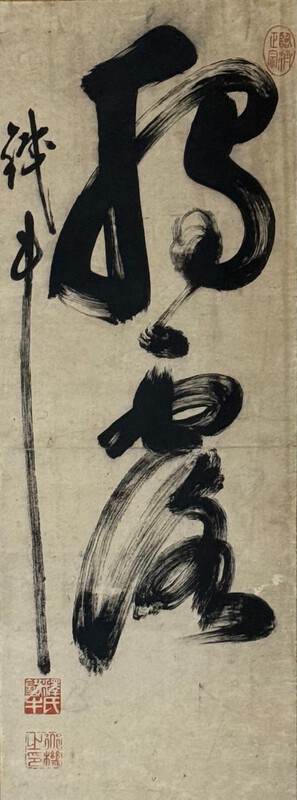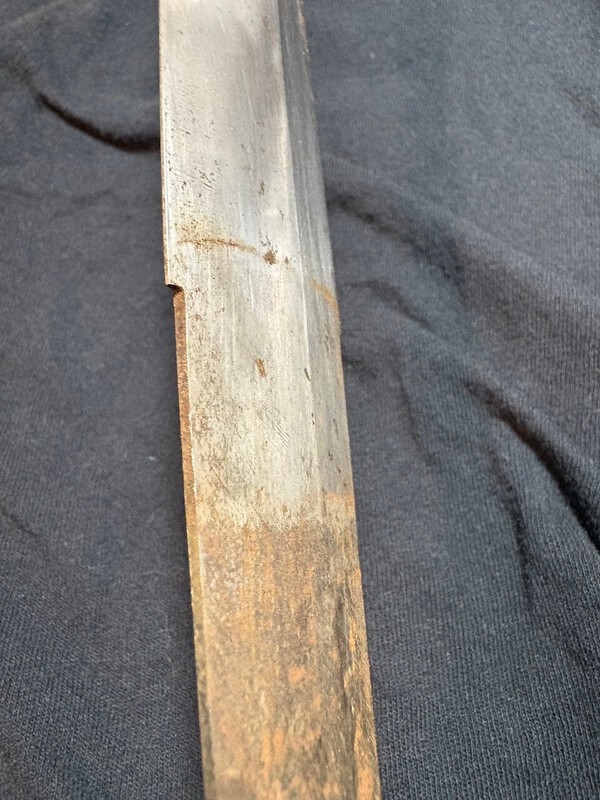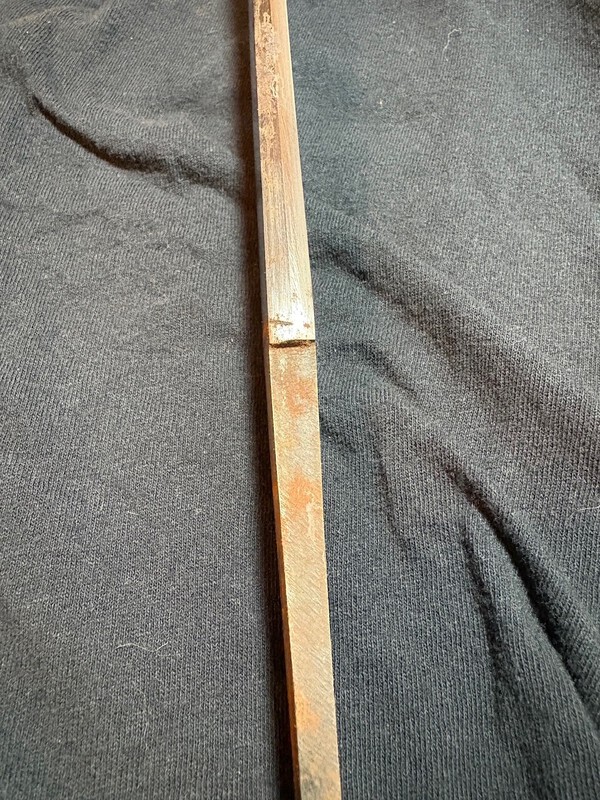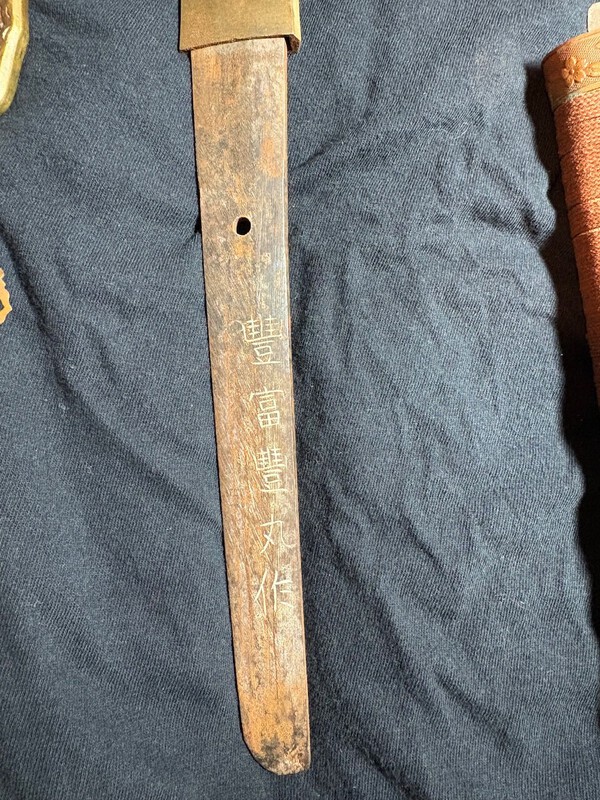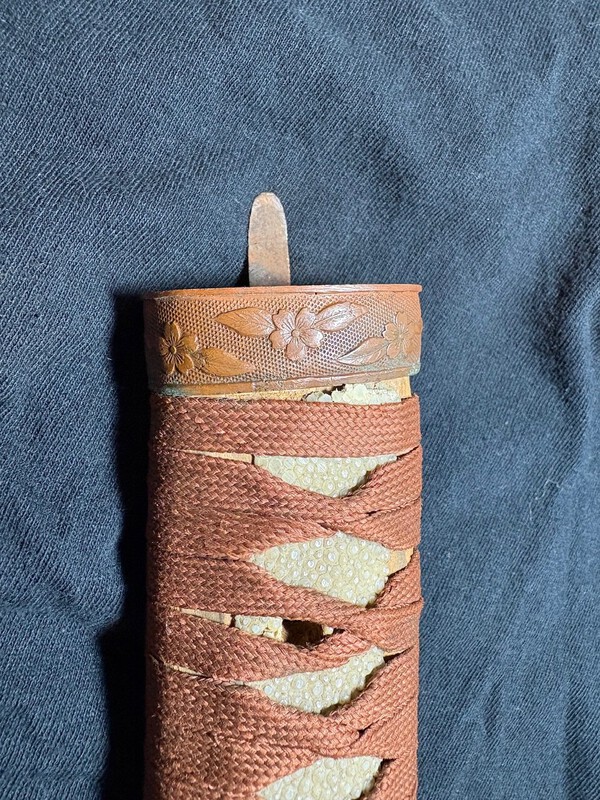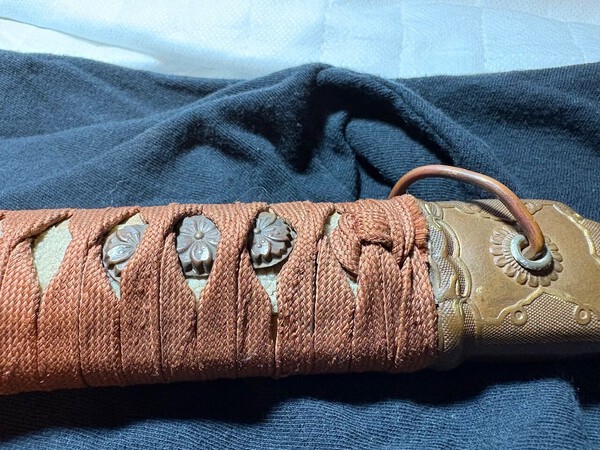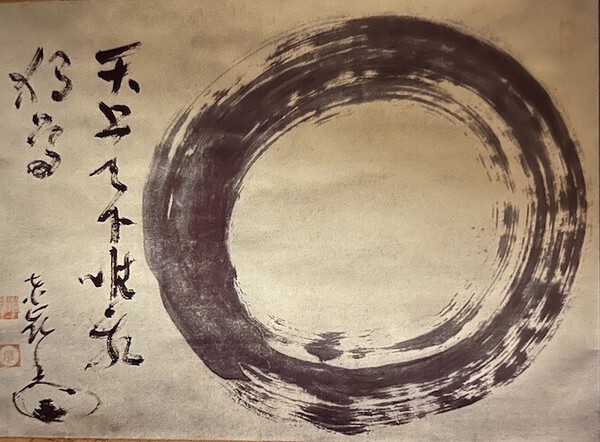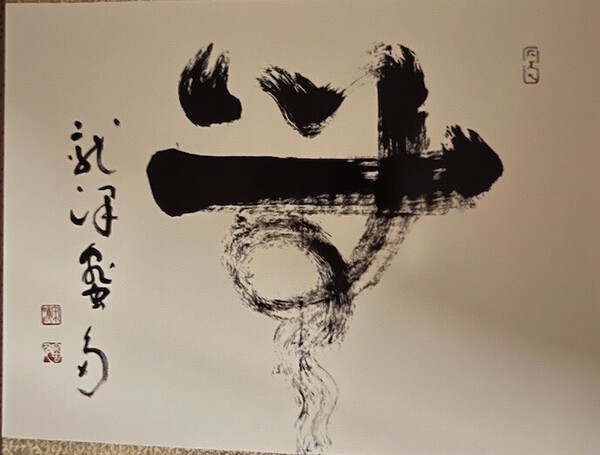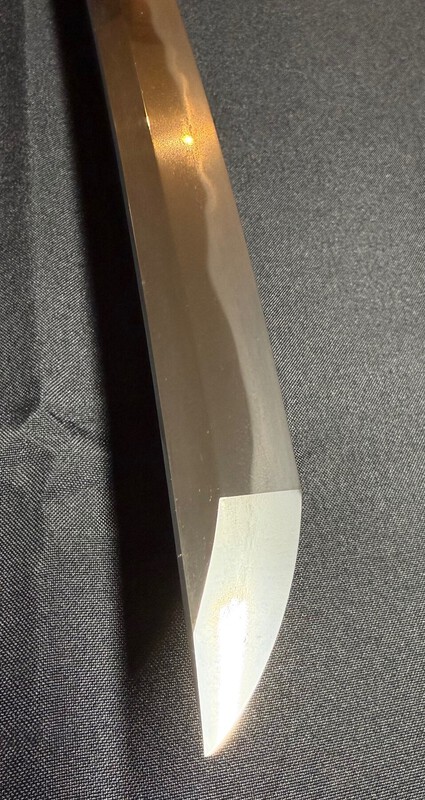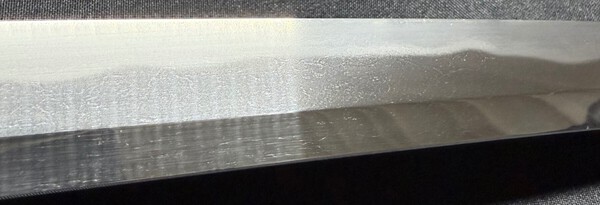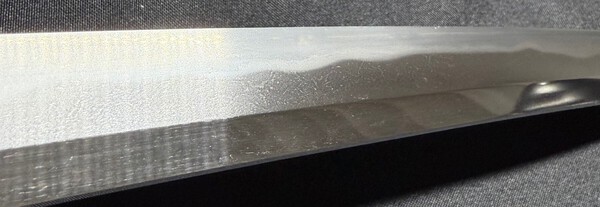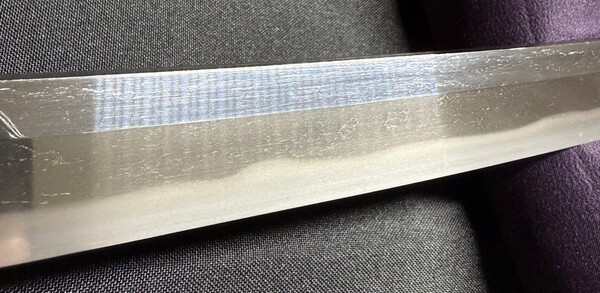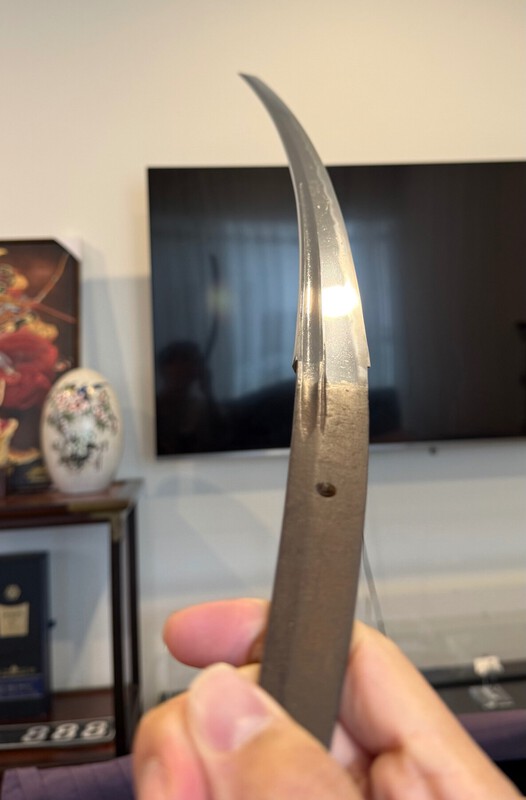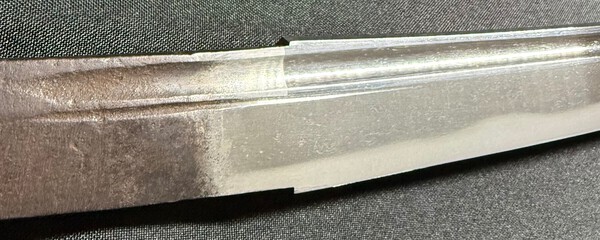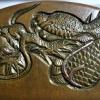All Activity
- Past hour
-

Is this an authentic WW2 Japanese sword?
Bruce Pennington replied to TroyUT's topic in Military Swords of Japan
Bit of a mixed bag. The wrap is folded the Chinese way, for sure. Surprising detail on the fuchi, if it's a fake. The machi and kissaki have proper shapes for a Japanese blade, but the fakes sometimes get that right. I could give it 50/50 chance between fake and late-war made in Manchuria legit. On second thought, though, the mei looks bad. Waiting for the translation guys on that. As to plastic rayskin - it's called cellulite. The Japanese used it throughout the war. I used to think it was a late-war item, but I've seen several gunto using it with dates all through the war period. - Today
-
Beautiful workmanship, Adam! I have a few of his blades on file. 6 of the 14 are Showa stamped, and are undated. There is corrosion above the mei which would hide any stamp that may be there, but there may not be one at all. Love the "3" stamped in kanji. rare to see a blade numbered in kanji, but not unheard of. Only one other blade on file is numbered and it's in Western numerals. Wildly speculating, but with no date and kanji numbering, I'd say this blade was made fairly early, like mid-late 1930s. But that's just pure guessing.
-

Kanenobu Katana (NBTHK Tokubetsu Hozon)
Volker62 replied to Matthew S's topic in Swords and Edged Weapons
great package Matthew good luck with this sale!! -
Thanks all, The photos are much easier for me to see on my screen for some reason. I’ll see if I can change some settings or retake. I see no signs of suriage, the file marks seem to come right up to just below the habaki. Edward
-

Kobayashi Taigen, Zen Calligraphy of "Ichi" (一)
Iaido dude replied to Iaido dude's topic in Other Japanese Arts
Then there is the fantastic work of Nakahara Nantenbo. I am following this kakejiku on Yahoo Japan of his often brushed nanten stick with the threat "Nanten bo if you follow the path, Nanten bo if you cannot follow the path!" His disciples got whacked either way! I knew there was a reason I didn't become a Zen monk. This one is about JPY 33,000. The finest examples in which that blob of ink on top is even more dramatically splashed like a Jackson Pollack painting go for thousands of $$. -

Kobayashi Taigen, Zen Calligraphy of "Ichi" (一)
Iaido dude replied to Iaido dude's topic in Other Japanese Arts
The Torei Enji Enso is one of my favorites. It's so important that it is reproduced on the cover of Stephen Addiss's book on Zenga. In that book there is a 2 character calligraphy that is translated as "Self Revealed," which I tracked down to the then private owner through a zen art dealer and eventually acquired. I realized that there is a kind of advantage in not being able to read kanji in cursive script, which then allows one to just focus on the powerful form itself. After looking at hundreds of works by a particular Zenga master, I begin to recognize his idiosyncratic and highly consistent script. "Self Revealed" by Tetsugyu (1628-1700). He was a Chinese Obaku sect Zen master who studied with Teishu, Ryukei, Ingen, Mokuen, and Sokuhi. The last three were leading Zen masters who were also noted calligraphers of his time. -

Council
Stephen replied to Pritajeni1's topic in Sword Shows, Events, Community News and Legislation Issues
I propose this be moved to the laugh of the day -
I think these would be the sayagaki 相州住正宗 - Sōshū jū Masamune (for this I did not know the first kanji but it seems common way of writing 相 in sayagaki as I checked some reference sayagaki from various authors) 大和国貞行 - Yamato Kuni Sadayuki 和泉守兼定 - Izumi no Kami Kanesada X国弘 - X Kunihiro (I cannot read first letter with confidence but guess this could be Sa Kunihiro 左国弘) 濃州住兼X - Nōshū jū KaneX (I cannot read last one confidently) 尾州住政秀 - Bishū jū Masahide 備州長船兼光 - Bishū Osafune Kanemitsu 備州長船祐定 - Bishū Osafune Sukesada X兼安 - X Kaneyasu (I cannot read first one confidently) - This one is too artistic for me to read 越前国下坂貞治 - Echizen Kuni Shimosaka Sadaharu 無銘粟田口 - Mumei Awataguchi 相州住定宗 - Sōshū jū Sadamune (Not the Sadamune but a different one from c. Tenbun) 三条小鍛冶宗近 - Sanjō Kokaji Munechika
-
Is this an authentic WW2 Japanese sword?
TroyUT replied to TroyUT's topic in Military Swords of Japan
-
Is this an authentic WW2 Japanese sword?
TroyUT replied to TroyUT's topic in Military Swords of Japan
-
Is this an authentic WW2 Japanese sword?
TroyUT replied to TroyUT's topic in Military Swords of Japan
-
Kobayashi Taigen, Zen Calligraphy of "Ichi" (一)
Chris Colman replied to Iaido dude's topic in Other Japanese Arts
Better overall shape and look to it. Torei Enji (1721-1792) Enso Nakagawa Soen (1907-1984) Mu Both dynamic flying white examples -
Kanenobu Katana (NBTHK Tokubetsu Hozon)
Barrett Hiebert replied to Matthew S's topic in Swords and Edged Weapons
Matthew, What is the weight of the blade? Thanks. - Barrett -
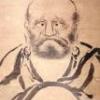
Masamune Kamakura era w/ Certificate
Shugyosha replied to Samurai95407's topic in Auctions and Online Sales or Sellers
Alex, If you look at the top of the page, on the banner there's a section marked "nihonto info," under that heading there is a "links" section which includes links to legitimate dealers in Japanese swords. You can use that to begin to get a feel for the market and what you can get for your money, but there won't be any Masamune blades by "the" Masamune on any of them. You can also check out the sales section on this forum as members are often selling blades and there's some nice pictures to look at. Please avoid buying on Ebay or the Japanese auction sites (probably best to avoid buying at all right now as you're shark bait; sorry): there are a lot of blades tricked out to look like something way more attractive than they really are like the second one you've posted above. I don't know where you get Masamune from there, it looks like a shinto blade that has been doctored to appear to be by Sekishu Naotsuna, I think. So in effect, you've been deceived twice in one go and you've barely got started. The new looking kinpun (gold) attributions on them is a big giveaway as if you check between blades, the style of writing is identical so someone has bought a comic with a free Japanese swordsmith kanji stencil set in it and they're really making use of it. Essentially if it's a blade claimed to be by a big name smith and it doesn't have modern NBTHK or NTHK papers, in most cases it can be discounted as a fraudulent attempt to deceive. Even if they do, you need to be sure that the papers are to the smith the buyer is claiming it to be as the names can relate to mulitiple generations of smiths with the same name, not all of which are well regarded or smiths from a different province with the same name who again may be inferior. A long-winded way of saying you need to know more before parting with any money. -
Is this an authentic WW2 Japanese sword?
TroyUT replied to TroyUT's topic in Military Swords of Japan
Thanks for the quick reply, I really appreciate it! Well now I’m going to contact the seller and eBay about getting my money back. I hope that goes well! -
The Buzen Usa Ju Nobukuni is here .
Bosco replied to Bosco's topic in General Nihonto Related Discussion
-
The Buzen Usa Ju Nobukuni is here .
Bosco replied to Bosco's topic in General Nihonto Related Discussion
-
The Buzen Usa Ju Nobukuni is here .
Bosco replied to Bosco's topic in General Nihonto Related Discussion
-
The Buzen Usa Ju Nobukuni is here .
Bosco replied to Bosco's topic in General Nihonto Related Discussion
-
Usa Ju Nobukuni Newest sword in my collection. And yes, almost sliced my hand off coming out of the box. Haven’t had the chance to study it in depth yet, but here are some specs: Nagasa: 75.4 cm Sori: 2.8 cm Motohaba: 3.02 cm Sakihaba: 1.93 cm Motogasane: 0.67 cm Sakigasane: 0.43 cm Weight: 681 grams Signed “Usa Ju Nobukuni – August Day”(宇佐住信国 八月日), this katana was forged in the Tenshō era (1570s–80s), during a time of great upheaval that culminated in the infamous Honnō-ji Incident. It was made in the final days of the Buzen Nobukuni school, just before they left Usa after their patrons, the Ajimu clan, were overthrown by Ōtomo Sōrin in 1582. The smiths later continued under Kuroda Nagamasa in Chikuzen, forming the Chikuzen Nobukuni lineage.
-
I bought this book not so long ago from Malcolm, he is great to deal with. Been after it for a long time and had never been able to get it, so get it whilst you can. Lots of info, actually found out more about about a Mino tanto i own, which was good. A signed copy too, so will thank Brian for that idea.
-
Is this an authentic WW2 Japanese sword?
Conway S replied to TroyUT's topic in Military Swords of Japan
Didn’t want to post a wall of text, but the kabutogane seen here is also typical of Chinese fakes.





